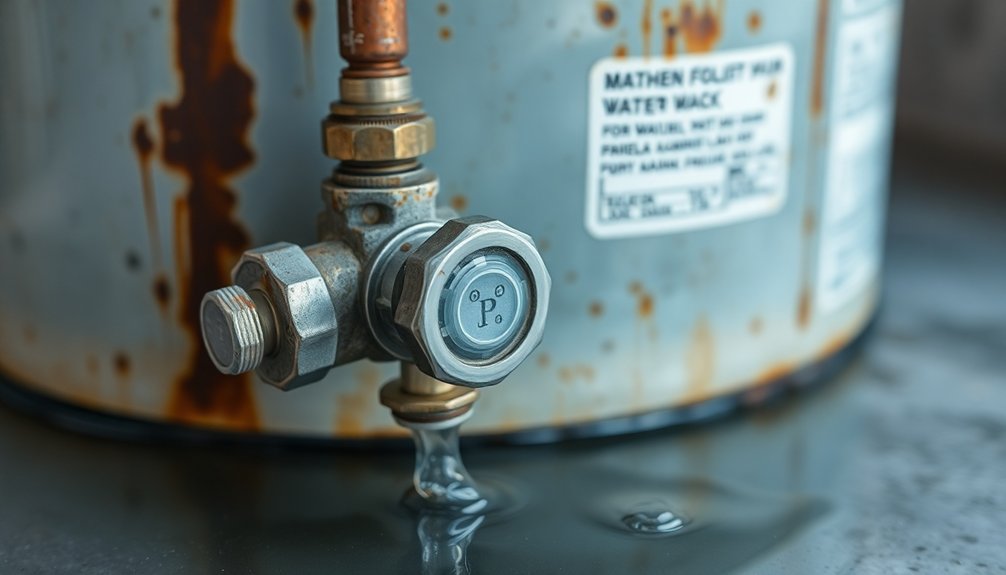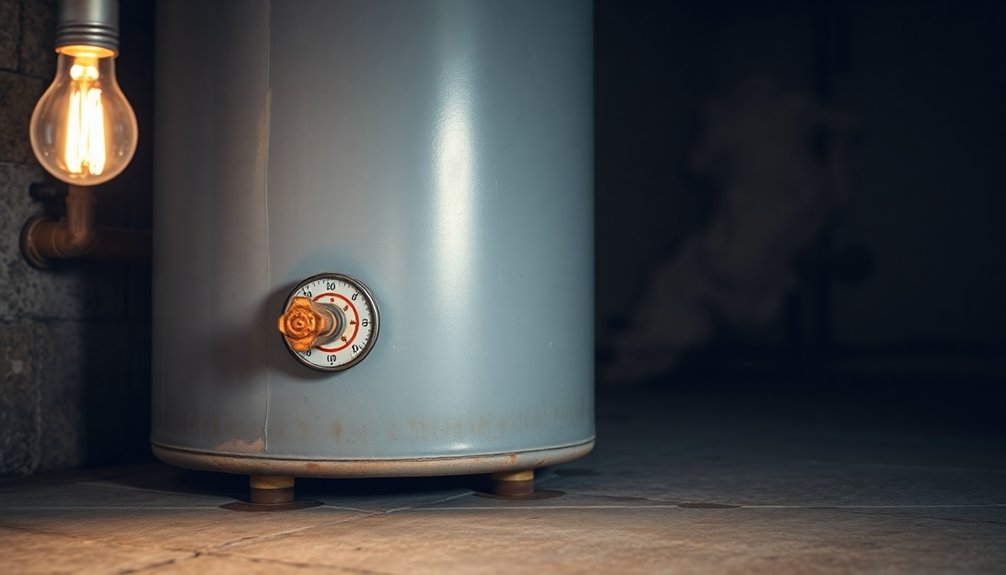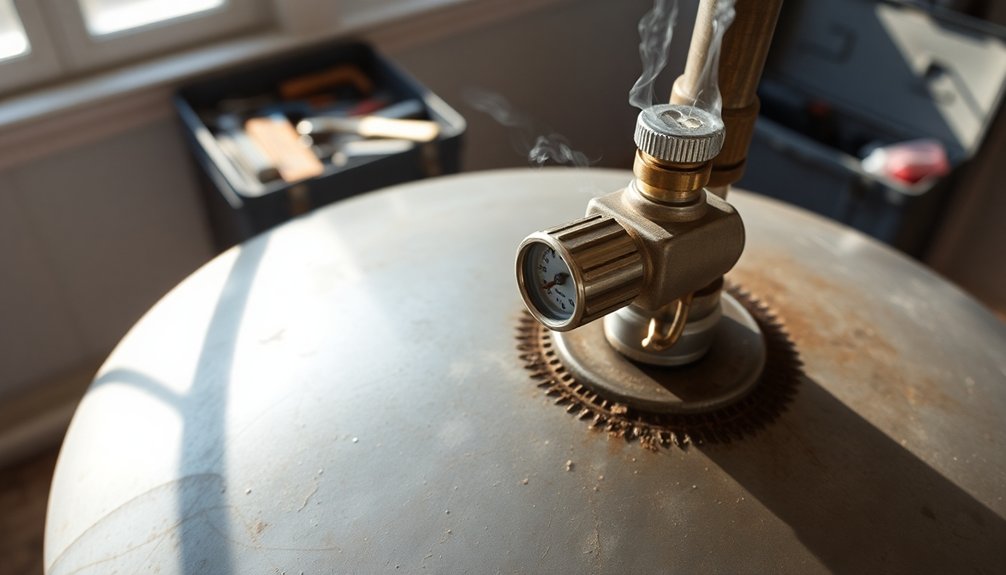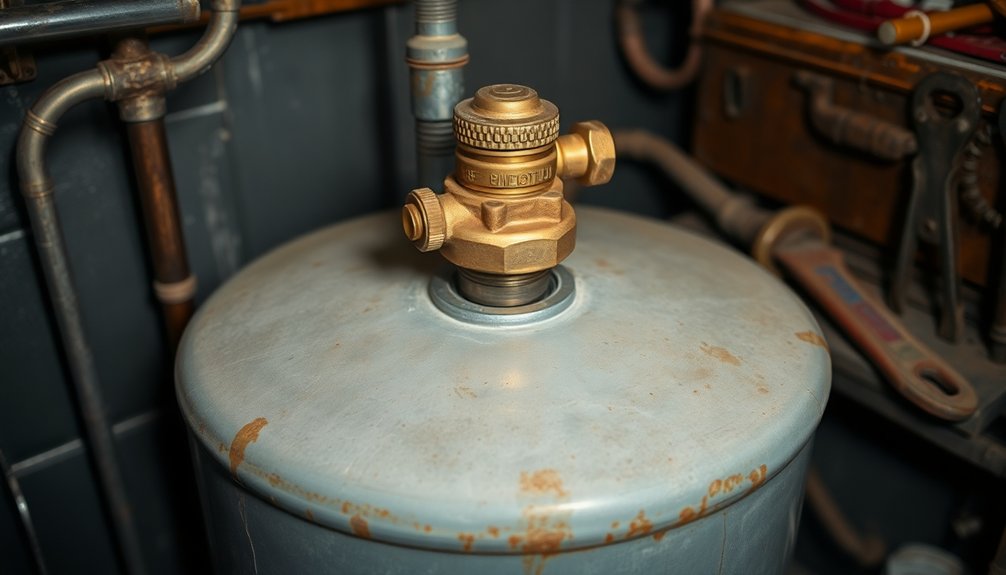Yes, older hot water heaters definitely need pressure relief valves. These valves are vital for preventing dangerous pressure buildup, which can cause tank ruptures. You should regularly test the valves to guarantee they function properly, ideally once or twice a year. If they’re faulty or show signs of malfunction, replacing them is affordable, typically costing between $10 and $15. To maintain safety and efficiency, it’s important to stay proactive with your water heater’s maintenance, and there’s more to reflect on.
Understanding Pressure Relief Valves
Understanding Pressure Relief Valves (PRVs) is essential for maintaining the safety of your water heater. These vital devices prevent dangerous pressure buildup by releasing excess pressure and steam, ensuring your system operates safely.
Over time, older water heaters may develop faulty or leaking PRVs, making it important to test them regularly—ideally once or twice a year. To test your pressure relief valve, lift the toggle and check for water discharge; if nothing comes out, it’s likely faulty and needs replacing.
Fortunately, replacing a leaking pressure relief valve is straightforward and typically costs between $10 and $15. Remember, PRVs are mandatory for closed water systems, and their proper functioning prevents hazards like tank ruptures or explosions from excessive pressure. Additionally, expense tracking tools can help homeowners manage maintenance costs effectively.
Importance of Regular Maintenance
While it may seem tempting to overlook routine maintenance, staying proactive with your hot water heater is essential for its safe and efficient operation.
Regular water heater maintenance helps prevent dangerous pressure buildup and guarantees consistent hot water availability. By inspecting the temperature and pressure relief valve annually, you can detect leaks early, potentially avoiding catastrophic failures and costly water damage.
A simple $10-$15 valve replacement is a small price to pay compared to emergency repairs. Neglecting maintenance can also lead to increased energy costs due to sediment buildup and malfunctioning components. Additionally, implementing regular billing process reviews can help ensure that you manage maintenance costs effectively and avoid unexpected expenses.
Ultimately, routine maintenance extends the lifespan of older hot water heaters, reducing the likelihood of sudden breakdowns and providing peace of mind in your home.
Signs of a Malfunctioning Pressure Relief Valve

When the pressure relief valve on your water heater starts to malfunction, it can lead to serious safety issues. You may notice water pooling around the valve or the discharge pipe, indicating a leak that suggests overpressure in your system.
If the valve discharges frequently, it could signal that your water heater is overheating or that there’s excessive pressure buildup due to a faulty thermostat. Additionally, if the valve fails to discharge water when lifted, it’s likely faulty and needs immediate replacement.
Regular testing of the pressure relief valve is essential, as older valves may develop leaks after being opened. Addressing these signs promptly guarantees safety and prevents catastrophic failures in your water heater system. Furthermore, timely reminders for maintenance checks can help ensure the longevity and safety of your water heater.
How to Test Your Pressure Relief Valve
Testing your pressure relief valve is a straightforward process that guarantees your water heater operates safely and efficiently.
Start by placing a 5-gallon bucket under the valve. Lift the toggle to check for water discharge; if the valve is functioning properly, water should flow out.
It’s recommended to test the pressure relief valve at least once a year to verify it operates freely and to clear any sediment build-up that may hinder performance.
If no water discharges when you lift the toggle, the valve is likely faulty and should be replaced immediately to avoid dangerous pressure buildup.
Replacing a leaking valve is a simple task and typically costs between $10 and $15, confirming your water heater remains safe. Additionally, maintaining financial discipline through regular checks can help avoid costly repairs in the long run.
Common Issues With Older Pressure Relief Valves

Older pressure relief valves can present several common issues that compromise the safety and efficiency of your water heater.
Over time, these valves may develop leaks, especially after testing, necessitating their replacement to guarantee safe operation. Regular testing is essential, as failing pressure relief valves can lead to dangerous pressure buildup, increasing the risk of explosion.
Older pressure relief valves can leak over time, making regular testing crucial to prevent dangerous pressure buildup and potential explosions.
Additionally, older valves can become corroded or clogged, reducing their effectiveness in relieving excess pressure and temperature. It’s recommended to test the temperature and pressure relief valve once or twice a year to verify it operates freely. Automated expense tracking can help ensure that maintenance costs are accurately categorized and managed.
Fortunately, replacing leaking pressure relief valves is generally straightforward and costs between $10 and $15, making it an affordable maintenance task to prevent potential hazards.
Cost of Replacing a Pressure Relief Valve
Replacing a pressure relief valve typically costs between $10 and $15 for the part itself, making it an affordable yet vital maintenance task. However, if you opt for professional installation, additional labor costs may apply.
The straightforward nature of this replacement allows many homeowners to handle it independently, further reducing the cost of replacing a pressure relief valve. Regular testing is important; if the valve leaks during testing, it’s time for a replacement.
While the parts are inexpensive, the potential damage from a malfunctioning valve could far exceed the replacement cost. By incorporating inspection of the pressure relief valve into your annual maintenance routine, you can guarantee it operates correctly and avoid costly repairs in the future. Additionally, monitoring savings and investments is crucial for effective financial management and goal achievement.
Preventative Measures to Take

To maintain your hot water heater’s efficiency and longevity, you need to implement regular preventative measures. Start by testing the temperature and pressure relief valve, inspecting the anode rod, and flushing the tank to prevent sediment buildup. These steps can help avoid costly repairs and extend the lifespan of your unit. Additionally, consistent monitoring of your financial health can provide peace of mind, ensuring that you are prepared for any unexpected maintenance costs.
Regular Valve Testing
Regular valve testing is essential for maintaining the safety and efficiency of your hot water heater. You should perform this test once or twice a year to prevent dangerous pressure buildup.
To test the temperature and pressure relief valve, place a 5-gallon bucket beneath it, lift the toggle, and check for water discharge. If no water flows, the valve is faulty and needs replacement.
Regular valve testing also helps clear sediment accumulation around the valve, ensuring it operates effectively. Be mindful that testing may cause leaks in older units, but replacement costs only $10-$15.
Sediment Buildup Prevention
While sediment buildup can lead to inefficiency and potential damage to your hot water heater, taking proactive measures can greatly mitigate these risks.
Regularly flushing your water heater once or twice a year is vital for preventing sediment buildup, enhancing efficiency, and prolonging the unit’s lifespan. Sediment can insulate the thermostat, causing erratic temperatures and higher energy consumption, so flushing is essential for peak performance.
Additionally, inspect and test the temperature and pressure relief valve annually to clear sediment and guarantee safe operation.
Be alert for popping noises during operation, which can indicate excessive sediment buildup; if you hear these sounds, flush immediately.
These steps will help maintain the performance and safety of your hot water heater.
Anode Rod Inspection
Inspecting the anode rod annually is essential for preventing corrosion in your hot water heater.
A deteriorated anode rod can lead to costly tank damage, so make sure to check it regularly.
Follow these steps for effective inspection:
- Turn off the water supply.
- Drain a few inches of water from the tank.
- Use a 1-1/16 socket wrench to remove the anode rod.
- Look for excessive deterioration; if more than six inches of the core is exposed, it needs replacement.
- Keep in mind that if the rod is tight, you might need an impact wrench.
A well-maintained anode rod considerably extends your water heater’s lifespan by protecting it from rust and corrosion caused by minerals in the water.
When to Call a Professional

When should you consider bringing in a professional for your water heater issues?
If you notice water leaking from the temperature and pressure relief valve after testing, it’s essential to call a professional. They can replace the valve, typically costing between $10 and $15.
If your older water heater frequently has pressure issues or you’re uncertain about needing an expansion tank, consulting an expert can clarify your system’s requirements and guarantee safety.
Consulting an expert ensures your older water heater operates safely and meets your system’s specific needs.
Additionally, if you lack the necessary tools or find it challenging to remove the anode rod, a professional can help without causing damage.
Finally, if flushing the water heater or testing the pressure relief valve feels risky, seeking professional assistance is wise to avoid potential hazards. Implementing automated payment solutions can help ensure timely repairs and maintenance costs are covered without stress.
Additional Maintenance Tips for Older Water Heaters
To keep your older water heater running efficiently, you need to focus on regular maintenance tasks.
Annually testing the temperature and pressure relief valve, inspecting the anode rod, and flushing the tank for sediment buildup are essential steps. These practices not only enhance performance but also extend the lifespan of your unit. Additionally, utilizing budgeting apps can help you track spending habits related to home maintenance costs, ensuring you allocate funds effectively for necessary repairs.
Regular Valve Testing
Regular valve testing is essential for maintaining the safety and efficiency of older water heaters. You should test the temperature and pressure relief valve at least once or twice a year.
Here’s how to do it effectively:
- Place a 5-gallon bucket under the valve before lifting the toggle.
- Check for water discharge; no flow indicates a faulty valve.
- Replace leaking valves immediately, as they typically cost only $10 to $15.
- Regular testing prevents dangerous pressure buildup and clears sediment for peak performance.
- Neglecting this maintenance can lead to costly repairs or replacements.
Anode Rod Inspection
Testing the temperature and pressure relief valve is just one part of maintaining your older water heater; anode rod inspection plays an essential role in prolonging its lifespan.
Inspect the sacrificial anode rod annually to guarantee it effectively protects your water heater from rust. If you notice over six inches of the core exposed, it’s time to replace it.
To check the anode rod, turn off the water supply, drain a few inches of water, and use a 1-1/16 socket wrench for removal. A deteriorated anode rod can lead to accelerated corrosion, shortening your tank’s lifespan.
While accessing the rod may be challenging, replacing it costs only $10-$20, a small price compared to potential corrosion damage.
Sediment Flushing Frequency
Flushing your older hot water heater at least once or twice a year is essential for maintaining its efficiency and longevity.
Regular sediment flushing frequency helps prevent sediment buildup, which can lead to overheating and erratic water temperatures.
Here are some key points to remember:
- Turn off the water supply and power before flushing.
- Drain a few quarts of water from the tank.
- Flush the tank with cold water through the drain valve.
- Listen for popping noises during operation; they indicate excessive sediment buildup.
- Neglecting regular flushing can lead to costly repairs or replacements.
Conclusion
To sum up, regularly checking and maintaining your hot water heater’s pressure relief valve is essential for safety and efficiency. For instance, consider a homeowner who ignored valve issues, leading to a catastrophic failure that caused extensive water damage. By routinely testing and replacing the valve when needed, you can prevent such disasters. Stay proactive with your maintenance to guarantee your older hot water heater runs safely and effectively, protecting both your home and your wallet.


